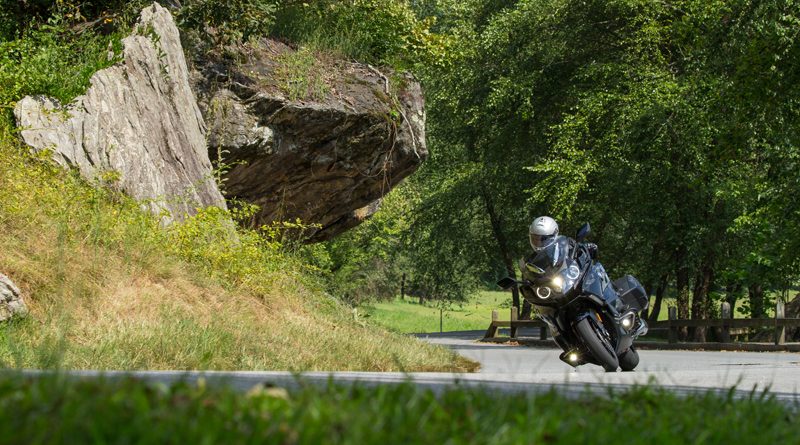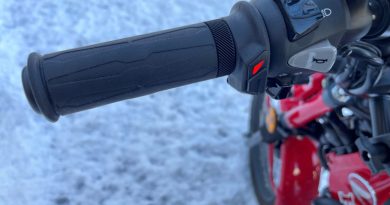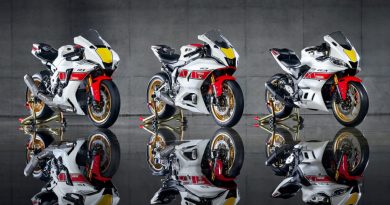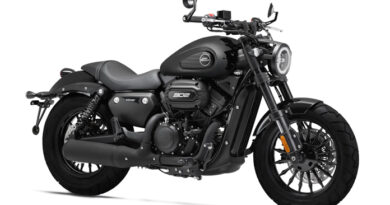Riding Cross-Country on a BMW K 1600 B

Though California has been my adopted home going on 15 years now, I’m a Southern boy. Born in Nashville. Lived in Charleston, Tampa, Atlanta and New Orleans. Taught manners and how to cook by three generations of steel magnolias. Learned a firm handshake from my father. And developed an abiding love of sweet tea, skillet cornbread and pulled-pork barbecue that borders on the religious.
Returning to the South often feels like a homecoming. Familiar, safe, humid. A few years ago, I found myself in Asheville, North Carolina, for the launch of BMW’s K 1600 B, a black bagger with the sort of edgy, go-fast profile and 160-horsepower in-line six one doesn’t normally associate with a feet-forward riding position. The folks at BMW planned the event to coincide with the solar eclipse that cut a 70-mile-wide “path of totality” across the United States, from Oregon to South Carolina, on Monday, August 17, 2017.

After the launch, with an electronic key fob in my pocket and a duffel bag Rok-strapped to the pillion seat, I embarked on my first — and so far only — cross-country trip by motorcycle. Riding across our great nation is like a pilgrimage, a journey both outward and inward that makes life richer and more meaningful, especially when done solo. Although I had a schedule to keep, the route, the stops and the tempo were up to me. Along the way I would visit family and pay my respects at important holy sites, such as the Ozarks and the highest paved road in North America.
The day of the eclipse was a strange one. We rode west, up and over the Smoky Mountains in a tight, fast formation on a winding stretch of I-40 that follows the Pigeon River, on our way to Gatlinburg, a popular tourist trap where, as kids, my brother and I spent hours wandering the arcades, tacky gift shops and Ripley’s Believe It Or Not Museum. We rode through the heart of Great Smoky Mountains National Park and over Newfound Gap on U.S. Route 441, a road built by the Civilian Conservation Corps during the 1930s that includes an elegant stone arch where the road loops over itself.

The partial eclipse — when the moon starts to take a “bite” out of the sun — began a little after 1:00 pm and lasted until after 4:00pm, but the totality lasted less than three minutes. And when it happened, it was as if someone turned out the lights. Eerie. And then, just as quickly, the lights came back on. Because the eclipse was such a big deal, a lot of people took the day off from work. Traffic on highways was backed up for miles. We did our best to filter through, to the chagrin of hostile and inebriated locals who didn’t like us cutting the line.
My solo journey began the next day. You could spend months exploring the Appalachians and never ride — or find — all of the good roads. There are plenty of famous ones, but many more hidden gems. I rode the 65-mile Copperhead Loop/Forest Heritage National Scenic Byway (NC State Route 215/U.S. Route 276), which slithers its way through thickly forested “hollers” and gaps and crosses over the Blue Ridge Parkway twice. Continuing south, I dropped by to see my cousin Emma at Furman University in Greenville, South Carolina, and I had dinner at Spiced Right BBQ (R.I.P.) with Emma’s folks and crashed on their couch in Lawrenceville, Georgia. I left at o’dark-thirty to beat rush-hour traffic and cruised west at a brisk pace on a series of interstates until I saw the familiar yellow-and-black sign for Waffle House in Jasper, Alabama. Pecan waffle well-done, hash browns “scattered, smothered and covered,” black coffee — if you know, you know.

Passed during the Eisenhower administration, the Federal Aid Highway Act of 1956 created an interstate network of highways that connected military bases and facilitated commerce. Some say the “superslab” brought an end to the American frontier, and motorcyclists consider it boring and soulless. If you’ve got the time to travel blue highways, by all means go for it. But if you need to cross vast distances in a hurry, the interstate can’t be beat. I fast-tracked my way across Alabama and Mississippi to get to the good stuff.
Rider has published dozens of features about motorcycling in the Ozark Mountains, and for good reason. Like the Appalachians, the area is a target-rich environment, full of winding roads following the contours of mountains, valleys and rivers, as well as charming small towns full of history and good food. This was my first taste of the Ozarks — roads in and out of Jasper, crossing the Buffalo National River, riding through Boxley Valley and scraping floorboards on the Pig Trail Scenic Byway — and I devoured as much as I could in the limited time I had.

To continue west, first I had to go north on I-49 to Joplin, Missouri, where a powerful tornado in 2011 claimed 161 lives and caused billions of dollars of damage. As I entered Kansas on U.S. Route 400 and began crossing the Great Plains, the terrain flattened out, the highway followed an arrow-straight course, the fields were filled with dry stalks of corn and weathered gray silos stood like sentries on the landscape. At Wichita I doglegged north on I-135, then continued west on I-70. As I approached Colorado, with cruise control set at 80 in a 75-mph zone and the K 1600 B humming along like the precision-made machine it is, I passed a sign for a border town called Kanorado. Of the 826 miles I rode that day, 500 were in Kansas.
After sleeping like the dead in a dump called 1st Gold Inn in Limon, Colorado, I continued west on I-70 to Idaho Springs, where I gassed up at Kum & Go. After hundreds of miles of interstate, it was a welcome relief to climb and lean my way into the Rockies. Up Route 103 to Echo Lake, then onto the Mount Evans Road and Scenic Byway (Route 5), the highest paved road in North America, topping out at 14,130 feet. Curve after curve, hairpin after hairpin, eventually above the tree line, doing my best not to target fixate on scenic vistas. A bluebird day with little fluffy clouds dotting the sky. Near the top, as if on cue, a group of white furry Rocky Mountain goats trotted out onto the road.

Perhaps the most stunning stretch of interstate in America is I-70 through the Rockies. The scenery is truly staggering, even if the traffic can be heavy. At 11,158 feet, the Eisenhower Tunnel bores a hole through the Continental Divide, and down the western slope signs warn “Truckers: don’t be fooled” and “Truckers, you are not down yet.” Up again to 10,666-foot Vail Pass. And then the dramatic ride through the Glenwood Canyon, with eastbound and westbound lanes at different levels clinging to the northern bank of the Colorado River on a series of viaducts, bridges and tunnels. I-70 through Utah is no slouch either, especially the stretch that passes through the San Rafael Swell, a massive reef of red rock. My 610-mile day ended in Richfield.
After visiting my father and stepmother in St. George, Utah, I rode down through the Virgin River Gorge across the northwest corner of Arizona and into the frying pan of the Mojave Desert. The BMW’s ambient temperature gauge stayed above 100 degrees for the next six hours, topping out at 115, as I rode across Nevada and California. By the time I reached the coast, it was 70 degrees with a blanket of fog just offshore.
Over the course of five days I rode 3,547 solo miles through 14 states. I once did a meditation retreat where I didn’t speak for 10 days. Both experiences were transformative because they were a refuge from day-to-day reality. Hours and hours passed while lost in thought. As riders, we’ve long been in the habit of doing what experts say is good for our health, whether it’s physical distancing to protect ourselves from a virus or putting down our damn smartphones to protect ourselves from insanity. We appreciate the value of solitude. We know the restorative power of a sweeping view, of time slowed down, of focusing on the road ahead. Motorcycling is about the here and now, the perpetual present moment. Namaste, y’all.

Riding Cross-Country on a BMW K 1600 B Photo Gallery:
The post Riding Cross-Country on a BMW K 1600 B first appeared on Rider Magazine.









